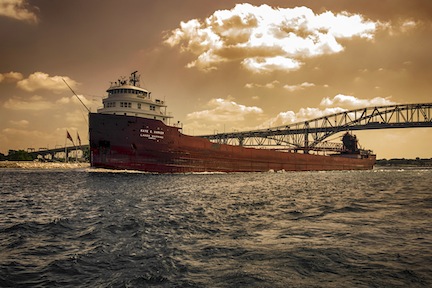The following is text of a news release from the Great Lakes Seaway Partnership:
(WASHINGTON) — The Great Lakes Seaway Partnership announces the release of "Economic Impacts of Maritime Shipping in the Great Lakes-St. Lawrence Region," a yearlong study of the economic impacts of the entire Great Lakes-St. Lawrence Seaway navigation system. The study is a definitive and detailed report documenting the many contributions made by the Great Lakes-Seaway system to federal, state/provincial and local economies.
The study reports that in 2017 maritime commerce supported:
• 237,868 jobs
• $35 billion in economic activity
• $14.2 billion in personal income and local consumption expenditures
• $6.6 billion in federal, state/provincial and local tax revenue
The study also highlights the specific economic benefits of key navigation infrastructure, such as the St. Lawrence Seaway locks and the Soo Locks. The study reports that in 2017:
• 123,172 U.S. and Canadian jobs were dependent on the Soo Locks
• 92,661 jobs were generated by cargo transiting the St. Lawrence Seaway locks
“This report validates what we’ve long known – that the Great Lakes-St. Lawrence Seaway is crucial to the U.S. economy,” said Craig Middlebook, deputy administrator of the U.S. Saint Lawrence Seaway Development Corp. “This bi-national waterway not only provides a multitude of well-paying jobs – on land and at sea – it offers a cost-effective, safe and fuel-efficient means of moving goods to and from domestic and global markets.”
The Great Lakes-St. Lawrence Seaway (comprised of the five Great Lakes – Superior, Michigan, Huron, Erie and Ontario – their connecting channels and the St. Lawrence River) serves the industrial and agricultural heartland of the U.S. and Canada. If the region was its own country, it would be the third-largest economy in the world with a combined GDP of more than $6 trillion. In 2017, 143.5 million metric tons of cargo (valued at $15.2 billion) moved through the Great Lakes-St. Lawrence Seaway.
The St. Lawrence Seaway is also the longest deep-draft navigation system in the world, extending 2,300 miles from its westernmost point in Duluth, Minn., to the Atlantic Ocean. North American farmers, steel producers, construction firms, food manufacturers and power generators depend on the system to move raw materials and finished products including iron ore, coal, stone, salt, sugar, grain, steel, wind turbine components and heavy machinery. These cargoes become the staples of everyday life: food and other household items, buildings, factories, roads and bridges; vehicles and planes, and provides the energy that powers cities and towns.
“The study reflects the enormous contributions the maritime industry provides to the more than 100 ports in each of the Great Lakes states and the provinces of Ontario and Quebec,” said Steven Fisher, executive director of the American Great Lakes Ports Association. “The jobs supported by the maritime industry include not only those located directly on the waterfront – shipyard workers, stevedores, vessel operators, terminal employees, truck drivers and marine pilots – but also grain farmers, construction works, miners and steelworkers. Many of these jobs would vanish if not for a dynamic maritime industry.”
The "Economic Impacts of Maritime Shipping in the Great Lakes-St. Lawrence Region" executive summary and full report can be found at http://greatlakesseaway.org/economy.

